Today, up to 78% of organisations in the education sector use learning management systems. These systems simplify course delivery, enable efficient learner progress tracking, and customise educational experiences to meet individual needs. On top of that, the custom development of LMS offers the potential for a 300% return on investment (ROI), often covering its costs within just 90 days.
However, the pricing of LMS can become quite confusing if you’re unsure what factors to consider and how the costs will align with your budget. To choose the best LMS for your needs, it’s critically important to grasp the pricing of such platforms, enabling you to make an informed choice – adopt an existing LMS or build it from scratch.

Learning management system: what's behind it?
LMS facilitates delivering and tracking educational and training content. Companies use it to onboard and train employees, while educational institutions proactively use it for teaching. E-learning tools within an LMS often feature customisable content, mobile-friendly lessons, and gamification elements. Implementing an LMS can boost employee engagement and enhance retention.
Learning management system LMS have several modules, including:
- Learning management: It enables registered users to organise and automate educational and training processes, as well as manage user information, schedule classes, send alerts and messages, and deliver content.
- Content development: Organisations can use templates or create content from scratch due to customization options. Course authoring tools allow administrators to design courses incorporating multimedia elements like PDFs, videos, animations, infographics, and PowerPoint presentations.

- Content library: The best LMS platforms come with a built-in content library that includes pre-made learning materials. This library may cover many topics, including safety regulations, customer service, and management techniques.
- Employee training: Some LMS platforms provide training courses, often focusing on onboarding, job-specific training, or instruction required for industry certifications.
- SCORM compliance: The Shareable Content Object Reference Model (SCORM) is a standard that allows LMS platforms to integrate third-party content without duplication or additional coding.
- Mobile learning: It enables students to access LMS content through a mobile app or web browser, allowing remote and asynchronous learners to complete courses while on the go.
- Gamification: Game-based learning environment encourages student engagement by offering incentives such as points, badges, and other achievements. The competitive, entertaining, and informal aspects of games help motivate learners to stay involved.
- Testing and assessments: Tests, quizzes, and assessments evaluate whether students have retained the material they’ve learned. These can be administered after each lesson or at the end of a course. Analytical tools help identify areas of proficiency as well as learning gaps.
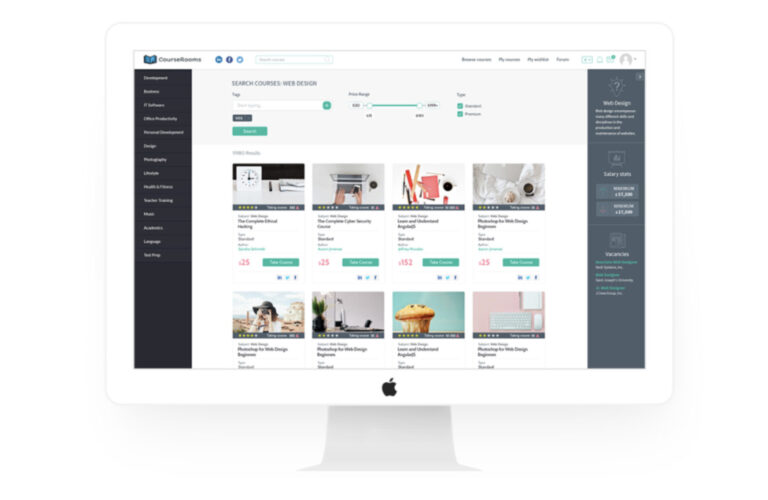
- Certification and compliance management: Certain industries or roles require employees to undergo certification or compliance training. This feature tracks and manages the completion of these requirements and can generate reports for auditing purposes.
- Performance tracking: Performance tracking and reporting features allow organisations to assess the efficiency of their learning programs. Organisations can gauge overall program success by analysing users’ course performance and the amount of time they spend learning.
Breakdown of learning management system pricing
How much does an LMS cost? While this may seem like a simple question, the answer is often complex. LMS software costs are usually not fixed, with various additional expenses involved. To allocate your budget more effectively and optimise costs, it’s important to understand these extra charges and hidden costs. Let’s explore the most common factors that contribute to the total cost of a LMS solution.
One-time expenses
- Setup fees cover expenses related to the initial setup and launch of the platform. This could involve costs for data migration, cloud hosting or server installation fees, and administrator training.
- Customisation of your LMS, such as integrating it with your existing CRM system or modifying the interface, usually incurs additional charges. For instance, connecting your LMS to other systems may require custom API development.
Recurring payments
- Subscription or licensing fees are regular costs, paid monthly or annually.
- Maintenance costs. While subscription plans usually include updates and patches, this may not always be true for open-source software or platforms that follow a pay-as-you-go cost model.
Additional costs
- Training. If the platform has a complicated interface, you may need to spend on training to help your team use it efficiently. To minimise this expense, look for an intuitive LMS with free resources such as tutorials and user guides.
- Support services. Certain LMS providers may charge for email or phone support or offer premium support options, such as a dedicated account manager, at an additional cost.
- Add-ons. You might have the option to buy more features beyond what’s included in your starter plan.
What are the LMS pricing models?
The LMS pricing model refers to how LMS vendors charge for using their LMS platforms. These LMS models can vary widely based on the type of customer (e.g., educational institutions, corporations), the scale of use, and the specific features or services provided.
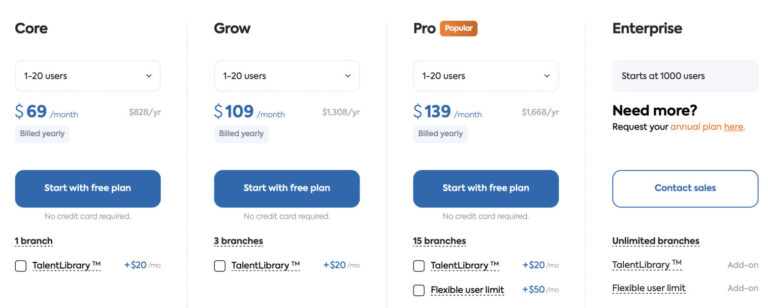
Image source: https://www.talentlms.com
Here’s an overview of the most common LMS pricing models.
Subscription-based pricing
- Per-user/Per-month pricing: A fee based on the number of active users per month.
- Tiered pricing: Here, customers choose from different pricing tiers based on the number of users, available features, or service levels.
- Flat-rate subscription: A fixed fee is charged regardless of the number of users, often for unlimited access to the LMS for a specified period (monthly or yearly).
Pay-per-use pricing
- Customers pay based on actual usage, such as the number of courses accessed, the amount of data stored, or the number of learning activities completed.
Freemium model
- The LMS offers a free basic version of the platform with limited features. Users can pay to unlock additional features, storage, or premium support.
Perpetual licensing
- A one-time fee is paid for the software license, allowing the organization to use the LMS indefinitely. This model often includes a separate fee for ongoing support, updates, and maintenance. It is more common with on-premise LMS installations.
Enterprise plan
- This model is often customisable, with pricing based on specific requirements like the number of users, features, support levels, and integrations.
Feature-based pricing
- LMS might offer core features at a base price, with additional charges for advanced reporting, e-commerce capabilities, or integrations.
How much does it cost to build an LMS platform?
Creating an LMS from the ground up involves multiple factors influencing its cost. Let’s examine the key elements that most significantly impact the price of a LMS.

Features and functionalities
The complexity of the LMS solution you require will dictate the amount of time and resources needed for its development and integration. Here are some key features that contribute to the overall cost of an LMS project:
- Course authoring tools. Instructors use these to create multimedia content, organise course materials, set up assessments, and track student progress.
- Assessment tools. These tools enable the creation of quizzes, tests, and surveys with automatic grading, feedback mechanisms, and reporting capabilities.
- Video conferencing. Live online classes or meetings require tools that support screen sharing, whiteboards, breakout rooms, and chat, which can be expensive.
- Social learning features. The LMS needs discussion forums, social media integration, and peer-to-peer interaction options to facilitate student interaction, idea sharing, and collaboration.
- Mobile responsiveness. A modern LMS should be designed for mobile use, including responsive design, mobile apps, and offline access for smartphones and tablets.
- Gamification. This feature allows instructors to incorporate game-like elements such as badges, points, leaderboards, and challenges into the learning process.
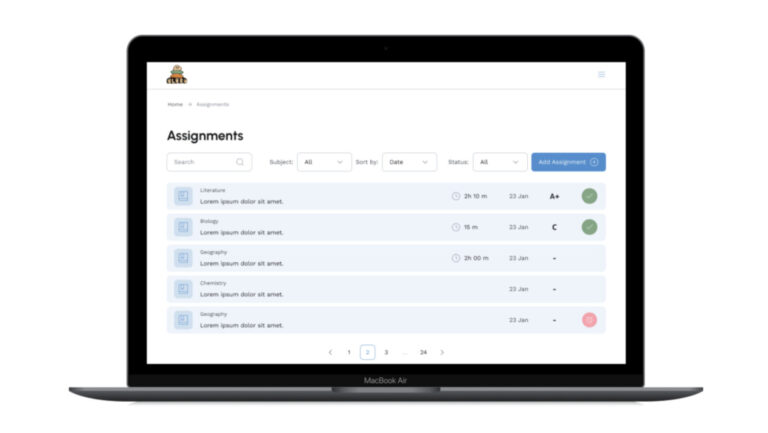
- Reporting and analytics. Dashboards, visualisations, and data export options are essential for tracking student progress, identifying areas for improvement, and generating performance reports.
- Customisation and branding. You may require custom themes, logos, and colour schemes to align the LMS with your branding and specific needs.
- Security and compliance. The LMS must ensure data privacy and security, featuring user authentication, data encryption, and access controls to meet regulatory standards.
Technology stack
The choice of LMS technology stack can greatly impact your project’s budget. Opting for more advanced technologies can raise development costs and enhance scalability, flexibility, and user experience. Conversely, using outdated LMS technology stack may lower development expenses but can result in a less efficient and secure LMS.
Here are some key tech stack components to consider when estimating your future costs:
- Programming languages: Modern languages, such as Python, typically require developers with niche skills, which can lead to higher rates.
- Frameworks and libraries: Using frameworks and libraries can streamline development and reduce costs, but cutting-edge solutions may still require skilled developers.
- Hosting and infrastructure. Cloud hosting solutions like Amazon Web Services or Microsoft Azure can significantly lower infrastructure expenses.
- Development tools and platforms. Integrated development environments (IDEs), code repositories, and project management tools improve efficiency and can help manage costs.
- Mobile responsiveness: Making an LMS mobile-friendly requires additional technologies, such as responsive design frameworks and mobile app development platforms.
- Scalability and performance: To ensure the LMS can accommodate many users and courses, technologies like load balancers and caching servers are necessary, influencing the overall development cost.
Each project requires a tailored approach and a thoughtfully chosen tech stack to guarantee timely delivery and code quality. At Altamira, we use the following technologies.
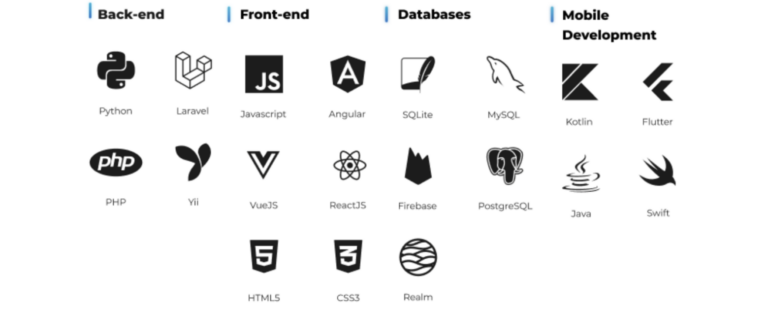
Integration with other systems
Integrating an LMS with other systems, such as HR or eCommerce platforms, requires additional development work. To estimate the potential costs, consider the following factors:
- Number of systems: Integrating multiple systems adds complexity to the project, generally increasing development costs.
- API availability. APIs that lack proper documentation can extend development time and raise costs.
- Data mapping and migration: Moving large volumes of data can lengthen the project timeline and increase expenses.
- Testing and validation: Ensuring the accuracy and reliability of integrations is a must, so make sure you pass thorough testing and validation of the system’s functions and performance by experts.
- Maintenance and support: Ongoing updates and regular technical support require additional resources, contributing to higher long-term costs.
UI/UX Design
Effective UI/UX design can greatly improve the user experience by making the system more intuitive and navigable. Here’s how the design phase affects the cost of LMS development:
- UI design complexity: Incorporating custom graphics, animations, or other advanced visual features can lead to higher development costs.
- UX design: Creating a user-friendly and intuitive UX that includes personalisation and multimedia support requires additional time and resources.
- Mobile responsiveness: Designing an LMS that works smoothly across various screen sizes and resolutions adds complexity to the development process.
- Accessibility: Making sure the LMS is accessible to users with disabilities involves detailed design and development efforts, which can increase costs.
Development team
The expense of hiring software developers can vary based on their location, expertise, and experience level. Here are a few factors to consider:
- Team size: A larger team can concurrently tackle various aspects of a complex project, leading to quicker development. However, this also results in higher labour costs.
- Location. Development costs are influenced by factors such as the cost of living, average salaries, taxes, and the demand for experts in different regions and countries.
- Skill level. More experienced mid-level and senior developers can deliver more sophisticated and practical solutions, but their salaries are generally higher.
The benefits of custom LMS development
A custom LMS software is designed to handle and deliver educational content online. It is specifically tailored to address the unique requirements of a particular organisation or institution.
What can you get with custom LMS?
- Personalisation. A custom LMS aligns with the company’s objectives and reflects its branding, making the learning experience more relevant and engaging for users.
- Flexibility. With a tailored solution, organisations can select the content, assessment types, and delivery methods (such as microlearning, gamification, or social learning) to create adequate and pertinent training programs.
- Scalability. A custom LMS can grow and adapt to the organisation, allowing for updates and modifications to meet evolving needs. This ensures that the software remains effective and relevant over time.
- Improved ROI. Custom software offers a better return on investment by lowering training costs, enhancing productivity, and boosting employee engagement.
- Integrations. Custom LMS can easily integrate with other software systems such as HR, content management, CRM, or AI platforms, streamlining the training process and enhancing data accuracy and user experience.
- Better analytics. Detailed analytics and insights a custom LMS provides help identify training needs, measure program effectiveness, and make informed decision for future initiatives.
- Security and compliance. Custom LMS can be designed to meet specific security standards and compliance requirements, such as HIPAA or GDPR, ensuring that training data is protected and regulations are adhered to.
Open-source LMS and its benefits
Optimising an open-source LMS involves enhancing the existing software to meet an organisation’s specific requirements. This process includes customising the user interface, adding or removing features, integrating with other systems, and improving performance and security.
Here are the key advantages
- Enhanced performance. Optimisation makes an open-source LMS run more efficiently, leading to faster page load times, smoother navigation, and improved performance. This results in a better learning experience, reducing user frustration and increasing engagement.
- Customisation. Optimisation allows for feature modifications, user interface enhancements, and integration with other systems to tailor the LMS to your needs.
- Reduced costs. You can lower development and maintenance costs while eliminating the need for hardware upgrades, streamlining workflows, and reducing expenses.
LMS development vs adoption: Cost comparison
Now, let’s examine the average costs associated with different types of learning management systems: custom-built, off-the-shelf, and open-source solutions.
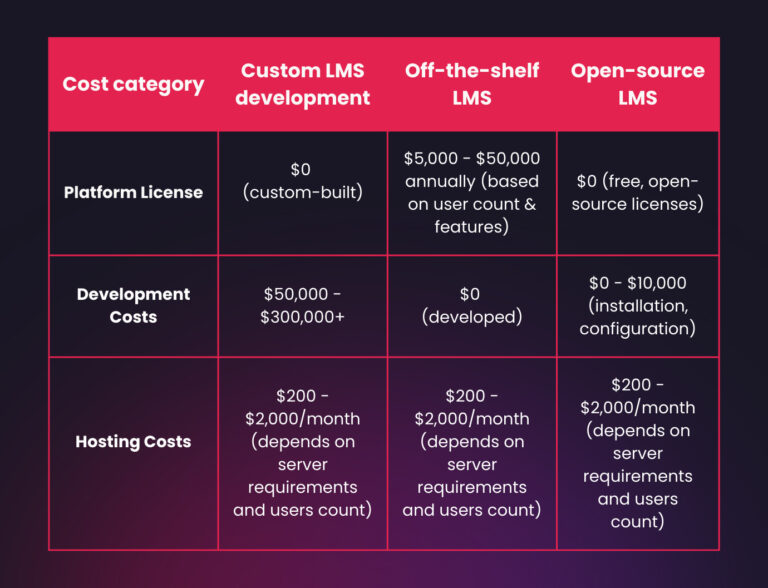
Please note that this comparison of learning management system prices is approximate. The actual cost of an LMS will vary based on the specific functionalities and customisation needs.
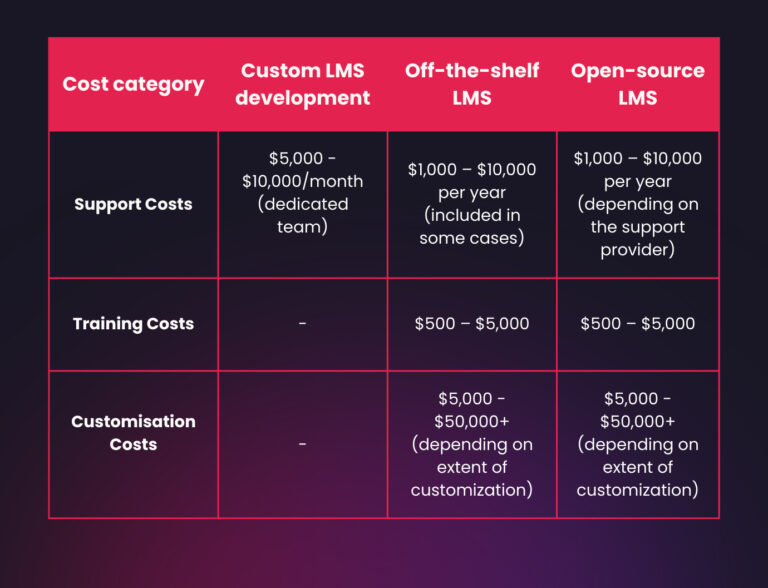
Tips to minimise the LMS development cost
Are you looking to cut costs on your project? Use these tips to optimise your LMS development budget.
Develop a Minimum Viable Product
To reduce the LMS development costs, create a Minimum Viable Product (MVP). An MVP accelerates the time-to-market and lets you collect early user feedback. This feedback allows you to refine features based on actual usage, enabling you to streamline development and use resources more effectively.
Prioritise features
Before starting development, perform a detailed analysis to pinpoint the crucial features of your LMS. There’s no need to include every possible function from the outset. Focus on the core features first and plan to enhance your MVP based on user feedback.
Use third-party APIs
There’s no need to create every software component for your LMS from the ground up. Leverage free or inexpensive third-party APIs to address your specific requirements. Additionally, take advantage of the support and resources available from many open-source communities to simplify the development process.
Outsource developers from low-cost regions
Consider hiring Altamira’s experienced development teams from regions with lower labour costs, such as Eastern Europe. Be sure to select outsourcing partners carefully, ensuring they possess the skills and experience that align with your project needs.
Consider scalability
Think about adopting a scalable architecture and infrastructure, such as a cloud-based platform, that can expand alongside your user base.

Use a modular design
A modular design strategy involves dividing the LMS into smaller, more manageable components or modules. This approach enhances development and testing efficiency and makes maintenance and updates more economical.
Invest in testing
Thorough testing and quality assurance help detect and address problems early in development. This approach minimises the risk of expensive errors and delays.
Conclusion
Navigating LMS pricing will undoubtedly become more complex in the coming years. Businesses interested in adopting an LMS should carefully evaluate their long-term objectives and thoroughly research different providers before making a decision.
Given the wide range of options available, there’s no need to rush the selection process. Choosing the right LMS or developing it from scratch can significantly impact your success, so take your time to make an informed choice.
With thoughtful consideration of key factors, even organisations with limited budgets can benefit from a cost-effective learning management system.
How can we help you?
Altamira is a seasoned software development provider that creates powerful LMS platforms for educational and corporate use. Our solutions smoothly integrate with your current systems, securely handle and store data, and offer access from any device.
Here are the key features of the LMS systems we develop
- Advanced capabilities of Artificial Intelligence to track learner progress, identify areas of improvement, and provide data-driven insights.
- Smooth communication throughout the educational process to boost collaboration and interaction.
- Comprehensive tracking to monitor learner progress and evaluate course effectiveness precisely.
- Efficient assignments management and assessment to provide personalised learning experiences tailored to individual needs.
- Qualitative data analysis methods to extract actionable insights and enhance learning outcomes.
- Gamification tools that foster interactivity and motivation.
Contact us to get a free professional consultancy.






